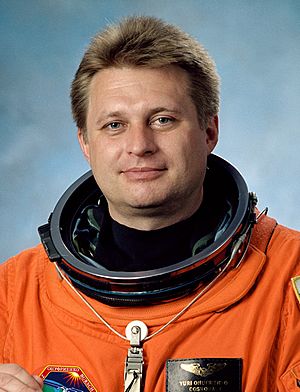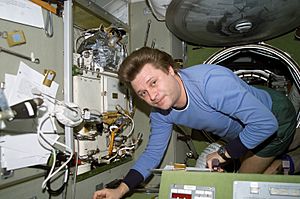Yury Onufriyenko facts for kids
Quick facts for kids
Yuri Ivanovich Onufrienko
|
|
|---|---|

Onufrienko in 2002
|
|
| Born | February 6, 1961 Ryasne, Ukraine, Soviet Union
|
| Status | Retired |
| Nationality | Russian |
| Occupation | Pilot |
| Awards | Hero of the Russian Federation |
| Space career | |
| Roscosmos cosmonaut | |
| Rank | Colonel |
|
Time in space
|
389d 14h 46min |
| Selection | 1989 TsPK Cosmonaut Group |
|
Total EVAs
|
8 |
|
Total EVA time
|
42 hours, 33 minutes |
| Missions | Soyuz TM-23, Mir EO-21, STS-108, Expedition 4, STS-111 |
|
Mission insignia
|
|
Yuri Ivanovich Onufrienko, born on February 6, 1961, is a retired Russian cosmonaut. He is famous for his two long trips to space. He lived and worked on the Mir space station in 1996. Later, he also spent time on the International Space Station (ISS) from 2001 to 2002.
Contents
About Yuri Onufrienko
Yuri Onufrienko was born in Ryasne, a village in Ukraine. He is married to Valentina Mikhailovna Onufrienko. They have two sons, Yuri and Aleksandr, and one daughter, Elena. Yuri enjoys many hobbies. These include playing tennis, cooking, fishing, and playing chess. He also loves anything to do with aviation.
Education and Training
Yuri Onufrienko finished the V.M. Komarov Eisk Higher Military Aviation School for Pilots in 1982. He earned a diploma as a pilot-engineer. In 1994, he also got a degree in cartography from Moscow State University. Cartography is the science of making maps.
Awards and Honors
Yuri Onufrienko has received many important awards. He was given the Hero of Russia medal. This is one of the highest honors in Russia. He also earned the title of Pilot-Cosmonaut of the Russian Federation. NASA also gave him Space Flight and Public Service Medals. In 1997, he was named a Chevalier in the French Legion of Honor.
Pilot Experience
Before becoming a cosmonaut, Onufrienko was a pilot. He served in the Soviet and later Russian Air Force. He flew for over 800 hours. He piloted several types of aircraft. These included the L-29, Sukhoi Su-7, Sukhoi Su-17, and L-39.
Cosmonaut Career
Yuri Onufrienko was chosen to become a cosmonaut in 1989. For about a year and a half, he went through special space training. After that, he trained to be a test cosmonaut. In 1994, he began training to command a backup crew for a mission to the Mir space station.
Mir Space Station Mission
From February 21 to September 2, 1996, Onufrienko commanded the Mir EO-21 mission. He launched into space aboard the Soyuz TM-23 spacecraft. His fellow cosmonaut, Yury Usachov, was with him. They docked with the Mir space station two days later.
A month after they arrived, NASA astronaut Shannon Lucid joined them. During their time on Mir, they did many science experiments. These included growing protein crystals and studying materials. A new module called Priroda arrived at Mir in April 1996. It was the seventh and final module for the station. Its main job was to study Earth's resources from space. Supplies were also delivered by the Progress M-31 spacecraft. After Shannon Lucid left, French astronaut Claudie André-Deshays joined the crew.
On September 2, 1996, Onufrienko, Usachev, and Claudie André-Deshays returned to Earth. Their Soyuz TM-23 capsule landed safely in Kazakhstan. In total, Onufrienko spent 193 days in space on this mission.
International Space Station Mission
Yuri Onufrienko returned to space as commander of Expedition 4 to the International Space Station (ISS). He launched on the Space Shuttle STS-108 mission on December 5, 2001. The shuttle, named Endeavour, docked with the ISS two days later.
The main goal of STS-108 was to bring supplies to the ISS. It also helped keep the station running smoothly. Onufrienko and two NASA astronauts, Daniel W. Bursch and Carl E. Walz, lived on the ISS for six and a half months. They tested station equipment and did maintenance tasks. They also helped prepare the station for more science experiments.
The Expedition 4 crew came back to Earth on STS-111. The Endeavour shuttle landed on June 19, 2002. With this mission, Onufrienko added another 196 days to his spaceflight time. This brought his total time in space to 389 days!
Spacewalks
Yuri Onufrienko has performed eight spacewalks in his career. These spacewalks lasted a total of 42 hours and 33 minutes. He is among the astronauts with the most spacewalk time. Six of his spacewalks were during his time on the Mir Space Station. The other two were during his visit to the ISS.
First Spacewalks on Mir
Onufrienko's first spacewalk was on March 15, 1996. He and cosmonaut Usachov worked outside for almost six hours. They installed a special boom and got ready to install a new solar array.
His second spacewalk was on May 20, 1996. They moved a large solar array from one part of Mir to another. They used the special boom to do this. During this spacewalk, they even filmed a commercial for a soda company, though it never aired!
On May 24, 1996, Onufrienko did his third spacewalk. He and Usachov finished installing the solar array on the Kvant-1 module. This spacewalk lasted over five and a half hours.
More Spacewalks on Mir
Onufrienko's fourth spacewalk was on May 30, 1996. They installed a special scanner outside the Priroda module. This scanner was used to study Earth's atmosphere. They also added handrails to help future spacewalkers move around. This spacewalk lasted 4 hours and 20 minutes.
On June 6, 1996, Onufrienko performed his fifth spacewalk. He and Usachov installed detectors to find tiny space particles. They also put out experiments to see how materials react to space. This spacewalk lasted 3 hours and 34 minutes.
His sixth spacewalk was on June 13, 1996. They installed a special structure called Rapana. This structure was a place to mount experiments. They also manually opened a large radar antenna that had not opened fully. This spacewalk lasted 5 hours and 42 minutes.
Spacewalks on the ISS
Onufrienko performed his seventh spacewalk on January 14, 2002. He and NASA astronaut Carl Walz wore Russian Orlan space suits. They moved a cargo boom for a crane. They also installed an amateur radio antenna on the Zvezda Service Module. This spacewalk lasted over 6 hours.
His eighth and final spacewalk was on January 25, 2002. He and NASA astronaut Daniel Bursch worked outside the ISS. They installed six shields to protect the Zvezda module's jet thrusters. They also installed another amateur radio antenna. They replaced an experiment that captured material from thruster firings. They also added two more experiments. One was to capture particles from the Sun and space. The other examined how different materials are affected by the harsh space environment. This spacewalk lasted almost 6 hours.
See also
- List of Heroes of the Russian Federation




